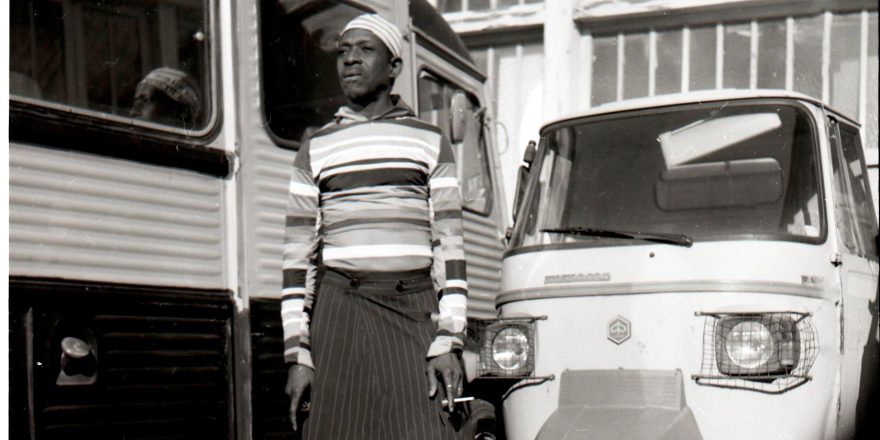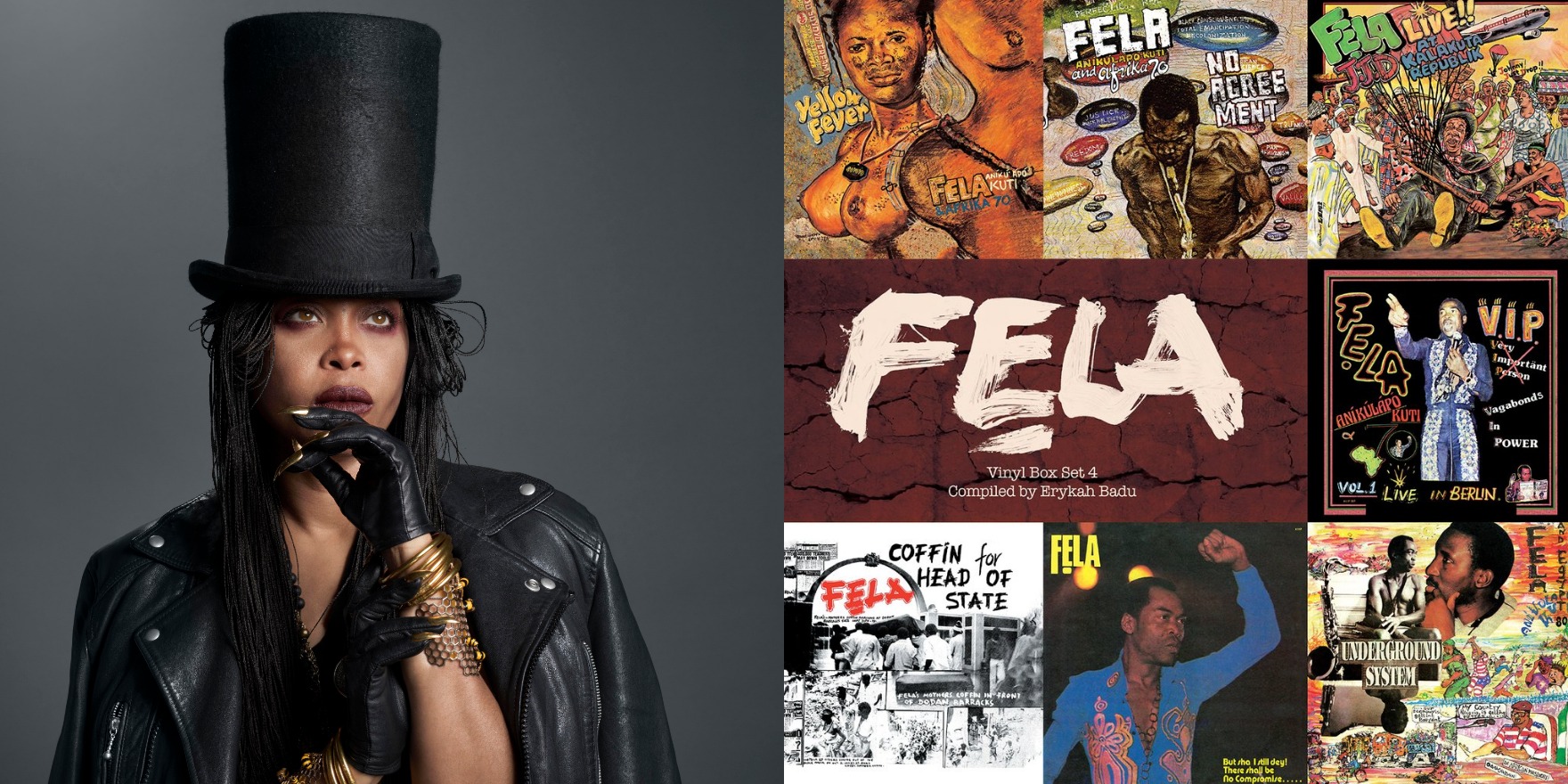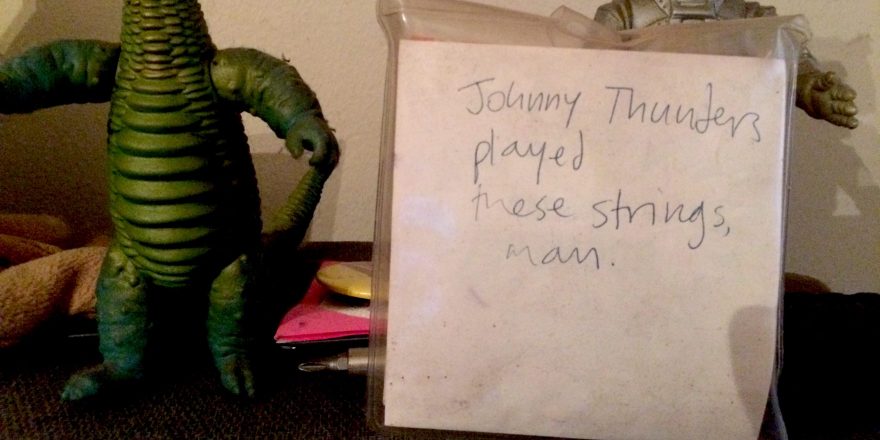In October 2009, when I was a freshman in college, I logged onto Myspace and sent a YouTube video of myself playing my favorite Antibalas songs on drums to their keyboardist, Victor Axelrod. “I’d like to give you some what I hope is constructive criticism,” he began in response. The thing Victor stressed first and foremost was that I had to study Fela Kuti’s music in a deeper way; specifically, I had to listen MUCH closer to Tony Allen’s drumming. Little did I know this advice would change the way I heard music, Afrobeat and otherwise, forever.
Over the next four months, on Myspace and in person, Victor — as well as, separately, saxophonist Stuart Bogie and drummer Chris Vatalaro — gave me a crash course in Afrobeat. (I eventually joined the band in 2010 and played with them up until 2016.) “Stylistically a lot of the things you’re doing when it comes to fills and also your energy is way too over the top,” Victor wrote to 19-year-old me. “Really pay attention to all the kinds of licks and fills that [Tony’s] NOT playing. Metaphorically, like if you have a knob on a stove that goes from 1-10, Tony is usually playing within 4-7. In your video, it feels like you’re always between 7-10.”
At that point in my life, that was humbling to read, but it was also extremely important. I had just arrived at jazz school and was feeling extremely self-conscious about my musical ability and therefore my identity in general. When I was 6 all the way through high school, I was “the drummer,” the music kid. I could play loud and relatively fast, and I always brought the fireworks when it came time for the drum solo in school concerts. Then, I arrived at jazz school, and my talent was immediately eclipsed by other kids who practiced all day and could play fast. Effortlessly fast. After botching my music theory entrance exam, I was put in Basic Musicianship, populated mostly by Music Business majors, which I thought was so below me (it wasn’t). I completely froze in my audition for the big band. I tried copping the jazz drumming vocabulary that I’d heard the other drummers throwing around, but it just wasn’t EASY for me, and that absolutely killed my fragile ego.
A lot of my jazz school teachers had been giving me honest and direct feedback, telling me all the things I needed to learn — but Victor’s feedback was different. “I think the key for you is to unlearn a lot of what you have in your vocabulary,” he responded, “and really check out the subtle, calm nature of Tony’s playing and ideas.” I welcomed that feedback and explained how I felt pressured to play more flashy to compete with other drummers posting videos: “It is hard sometimes to be ‘noticed’ if you are not showing your stuff, especially for a young drummer.” As I re-read it now, I can see my younger self coming up against something that I think all musicians, and people in general, come up against: feeling inferior because of what you perceive to be your weaknesses.
Victor then said something to me that I will forever be thankful for: “You need to develop the chops to execute the kind of ideas which represent YOU and not what you think other people want to see you playing. It’s common to see drummers and bassists who will refer to their respective patterns but they never ESTABLISH their patterns in any meaningful way and they just use any bit of space within the music to fill it up with their flashy ideas which don’t relate to the song/composition. Tony Allen [on Fela’s song] ‘Upside Down’ — he says SO much in that tune but he does it all within SPIRIT of the COMPOSITION — it’s all so relaxed. He’s always either setting someone up (like a horn entrance) or responding to something that just happened. And he NEVER makes a big deal of the moment.”
This lesson was so much bigger than just drumming. After Victor’s directive, I dove deeper into Tony Allen, and I slowly learned about how much of a world I was actually missing. We’re quick to think we know everything — about a song, a friend, a loved one — and slow to admit that we’ve only attained a surface understanding without really digging in. There is so much more to Afrobeat music than people think, and it’s all because of Tony.
Afrobeat drum patterns are just patterns — they can be transcribed and taught — but I look at Tony Allen’s drumming as a philosophy, containing lessons for life in general. “Be Yourself” is a worthy cliche, but it doesn’t take into account the world around you. So, I distill Tony Allen’s lessons down to: “Be Yourself, Support Others.” Under that umbrella, here are the micro-lessons I’ve learned from listening to Tony Allen, to infuse presence and mindfulness of others into daily life:
- Composition first
- Stay humble
- Support and respond
- There are no mistakes
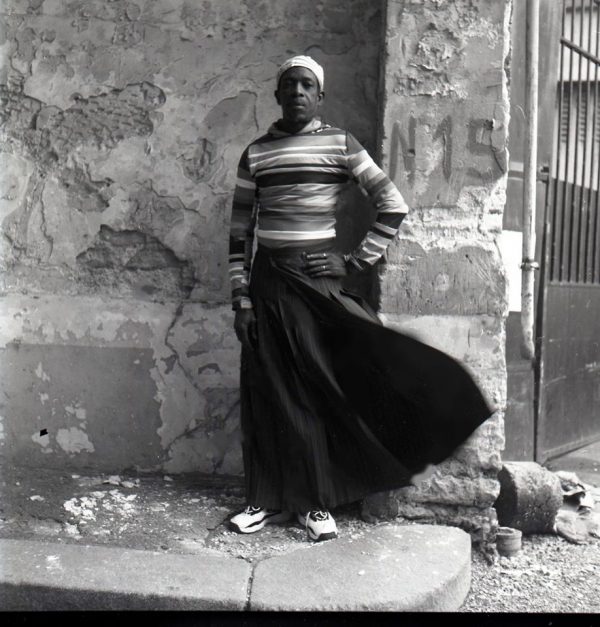
1. Composition First
Tony’s drumming on Fela Kuti’s “Roforofo Fight” holds an important lesson about ego in music that can be applied to life in general. By listening to Tony’s earlier drumming, pre-1970, you can hear his technical ability, but starting around 1970, he rose above his technique. The chops were still there (anybody learning his drum patterns can tell you that), but they came second. What comes first was always the composition, and Tony never overstepped what the song called for in that moment. No matter how much you think you know, respect the situation you are in and apply yourself to it in a personal and present way.
Fela Kuti’s “Roforofo Fight” contains one of the greatest 21 seconds in drumming history, five minutes and 10 seconds in — but there’s some context I need to explain before I get to why. Tony Allen grew up a jazz and highlife drummer before his life in Afrobeat began. He loved Tony Williams, Art Blakey, Elvin Jones… and in Fela’s earlier recordings you can hear Tony’s jazz influences the most directly. Listen to Fela’s “Obe” for example, especially at the 2:04 mark.
His fills feature a lot of fast rolls, jumping around the kit. It’s ambitious and BIG drumming, and though he clearly had amazing taste at an early age, there’s a bit of ego in his playing. Somewhere along the way, though, Tony’s vocabulary morphed into something greater than the jazz approach of his youth. His drumming rose above highlife, above jazz, above funk — he became Tony Allen. The patterns he played were suddenly compositional and intentional. His dynamic range, which was already wide, widened tenfold — he could be the quietest or the loudest instrument within one song. His ears got so present and reactive that on some songs he barely ever played the same groove two bars in a row, always responding to what was happening around him.
Fast forward from “Obe” to “Roforofo Fight,” from the 5:10 mark until 5:31 — I encourage you to listen in headphones!
Tony has matured, sure, but it’s more than maturing. The same technique is there, but he’s employing it only as it’s necessary, like it’s a secret. After going through the whole intro without playing any fills or major variations, at the two minute mark he plays an extremely meat-and-potatoes fill into the horn entrance. This is the definition of restraint. He holds onto that restraint until the 5:10 mark. First, he signals on the bell of the cymbal to cut the horns out, and he immediately brings the dynamic down to a simmer. After maintaining the pattern for a few bars, he then embarks on a little journey around the drumkit, effortlessly throwing around cymbal, tom and snare hits, building beautifully to Fela’s saxophone entrance. He manages to take a little drum solo in such a way that you don’t even realize that it’s happening — in fact, he is driving the song AT THE SAME TIME. The pattern remains intact, yet somehow he is also soloing (and there’s, like, eight other musicians playing at the same time). What other drummer can do that? Even though this requires advanced technique and coordination, this is ego-less playing. He uses the exact technique necessary for the song he is a part of, nothing more, nothing less. He takes risks, but he doesn’t disturb the composition. Even when he steps out to shine for a moment, he does it with respect.
2. Stay Humble
Tony’s drum pattern on Fela Kuti’s “Ikoyi Blindness” propels the song for 15 minutes straight, but you barely even notice it. The lesson here is simple: Be steady, be dependable, be there — no matter how thankless it may be. A community benefits from both its leaders and those working behind the scenes.
Here’s the tune, from 1976:
The way the band floats in this recording has mystified me since the first day I heard it. Anytime I’ve seen an Afrobeat band play this kind of groove, and anytime I’ve tried to play it with my own bands, it comes out clunky, overly-powerful, too “funky” — it doesn’t float. A lot of the instrumental parts (shekere, bass, guitars, horns) are downbeat oriented, hitting on the “1” with a heavy quarter note feel. So what gave Fela’s band the float? In my opinion, it all boils down to Tony Allen’s right foot.

His kick pattern accents the downbeats on beat 1 and 3 (in blue), providing a solid rock for the groove to stand on. But in between those beats, he adds a slightly softer upbeat kick JUST after beats 2 and 4 (in red). This pattern creates a downward slope leading to beat 3 and beat 1, while opening up space leading to 2 and 4. As a result, you have a feeling of tension (the downward slope) and release (a moment of space) happening on an incredibly micro level, working in every bar of the entire 15 minute track underneath the entire band. There is also a macro level at work: because of that downward slope leading to the downbeats on beat 1 and 3, a halftime feel begins to permeate through the whole song; so, even though on its surface “Ikoyi Blindness” is a barnburner party track, it retains the patience and LIGHTNESS of a downtempo track. All in Tony’s right foot.
When people talk about Tony Allen being Fela’s “secret weapon,” this is what they’re referring to, knowingly or not. While that kick drum movement is happening, Tony drives the band with his other limbs, which you can especially hear once the vocal section starts (for example, at 9:40). As Fela rifles through his lyrics at breakneck speed, Tony subtly cues in the vocalists and horn players, playing lead-in fills to their responses and leading the dynamics back down afterwards. For someone pulling that much weight, Tony never asked for any fanfare. He did his job, which was to be a rock for the band and for Fela. Eventually, Tony did clash with Fela and left the band, but throughout the rest of Tony’s life he referred to Fela as his brother and his friend.
Tony was humble back in the ‘70s and remained humble through the end of his life. That is a rare and beautiful thing that I try to keep in mind. I sometimes find myself yearning for credit that I feel I deserve, or talking myself into thinking that I deserve more. There’s a time and place to fight for your stake in things, but there’s a fine line between self-worth and selfishness. Whether it’s in a band, in business, or in relationships, sometimes you need to just step back, play your role, and have confidence in that role — thereby committing yourself to being supportive to others. Tony was world-renowned not for his drum solos or any kind of outsized personality; he spent his life being the backbone for the musicians around him, always serving the song.
3. Support and Respond
How can we support those around us? This is a question we should always keep with us, though it is so easy to forget. On the drums, Tony Allen always responds to whatever is happening in the foreground — which he picked up in his early days from American jazz drumming greats like Tony Williams — but he never actually outshines the foreground. Some of Tony’s most supportive moments as Afrika ‘70’s covert bandleader come in the vocal sections of Fela’s epics. He subtly leads the vocalists, the horn section and sometimes even Fela himself through the intricate arrangements. This indicates that, other than Fela himself, Tony was the only one who had the entire arrangement in his head, accounting for all the parts happening and thinking ahead to what was to happen next. He wasn’t just a drummer playing along.
Listen to Fela’s “Alagbon Close,” starting at the vocal section at the 7:03 mark, and follow the diagram through it.
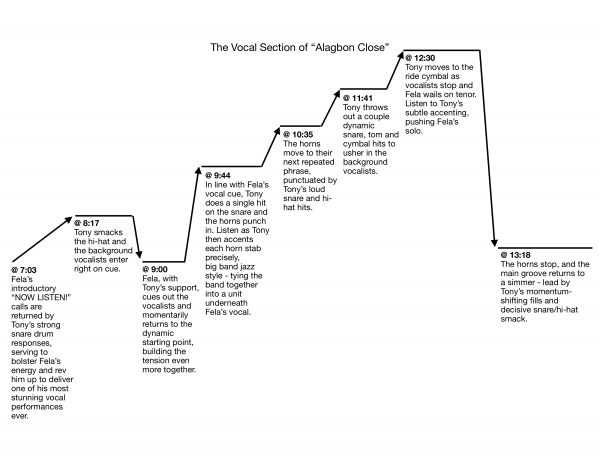
This vocal section is a winding road, paved by Fela’s delivery and navigated by Tony’s cues. At every new level of the section, Tony is there to both facilitate Fela’s composition and to support the band, making sure they come in on point. The song moves through its dynamic arc in such a way that could only happen if the lead singer/songwriter and the drummer are on the exact same page. Fela delivers his lead vocal with intense fervor, with larger-than-life control over his huge ensemble, and he is made even stronger by Tony’s guiding hands. The band is operating with a net — they have Tony, the rock, the leader behind the leader. You can hear this support and response in all of Tony’s recordings. He is always receiving and processing information supplied by the players around him.
The lesson here is to always be open to supporting others and bolstering others to perform at their best. Listening and paying close attention — this is what sets Tony apart from other legendary drummers. His ears are just as big of a part of his sound as his snare drum or kick drum. In fact, the difference between Tony and other drummers is shown quite clearly on Fela’s collaborative album with late Cream drummer Ginger Baker. Baker clearly had a good feel for the music and knew how to swing with the band, but he also relished the opportunity to go wild soloing on his toms. On the reissue of the Fela Kuti and Ginger Baker Live! album, they included a 16-minute track called “Ginger Baker and Tony Allen Drum Solo” from a live festival show in 1978. A more apt title would be “Ginger Baker Solos While Tony Allen Supports,” as Tony spends most of the time on his hi-hat while Ginger rolls around his toms at light-speed. No disrespect to Ginger Baker! In that moment in time, crowds loved seeing him do his wildman thing, and it was Fela’s show anyway. When there was an opportunity to support, Tony was there.
4. There Are No Mistakes
When I mess up, whether it’s on the drums, in a conversation, in a photograph… I am hard on myself. When I dug into Tony Allen’s drumming in my first year of college, I was self-conscious about all the holes in my technique (and therefore, identity) that were appearing so suddenly. Tony’s energy, so powerful and serenely patient, helped me reframe my weaknesses as inverted strengths. Our minds have this sly tendency sometimes to identify by we are NOT, instead of encouraging us to embrace who are ARE. Now, years later, whenever I feel those less-than feelings, Tony Allen’s drumming guides me back to me.
Across many of Tony’s recordings, if you really dig, you will find what can be interpreted as mistakes. Sometimes he appears to trip up a little. But somehow, you barely notice it — because he makes mistakes irrelevant. He constantly folds his drumming in on itself, taking whatever path that suddenly arises out of his playing. There is an astounding presence in his drumming. Everything is constantly digested and recycled in real time, so nothing is ever an error. There is no auto-pilot.
Listen to Fela’s “Upside Down,” at around the 14:08 mark:
At 14:10, less than a minute from the end of the song, there is a majorly off-kilter moment that comforted me deeply when I was 19 and still does to this day. In the space where Tony usually gives a “fill + single snare whack” response to Fela’s keyboard call (a recurring theme throughout the song) you can hear what sounds to me like fumbling drumsticks, rattling against a drum. He quickly snaps back and whacks the snare drum, just like he does every other time… but was that a misstep? Did he drop his stick for a second? The thing is, even when he possibly fumbled a drumstick, his train kept moving. Maybe a young Tony Allen, learning the drums and building his technique, would’ve been embarrassed or halted by a mistake like that, but he realized that actually learning from his mistakes and building off of them was more fruitful.
When we look at our idols, those we consider the greats, we like to say they “aren’t human,” as if their craft is magically exempt from error. It follows, then, that if you want to achieve greatness, you have to be perfect every time. What makes a musician great is not their perfection, it is their ability to learn from their mistakes and incorporate them. The concept of a mistake becomes irrelevant — instead, it’s a path change. Tony Allen’s drumming was deeply human because it was imperfect, without a front to make you think otherwise. It got to the essence of what it is to be human: making mistakes, learning from them, and growing stronger and wiser in the process.
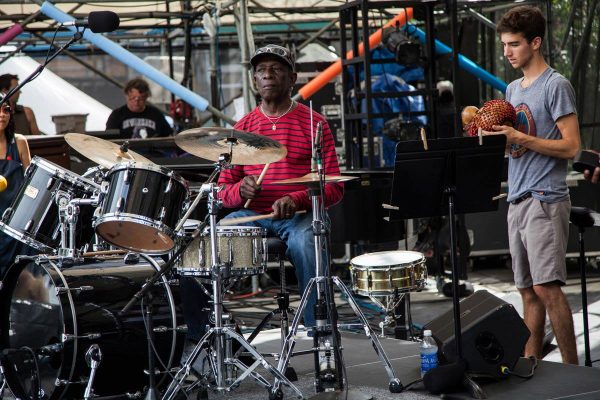
I got to play and hang with Tony a few times, times which I cherish greatly, but of which I don’t remember the specifics too well. They were a blur. Part of me wishes I had taken voice memos every time I hung with him, but I’ve come to accept that I was just soaking up his energy more than anything else. I do remember what it felt like to be in his presence, to stand next to him, to hear his speaking voice in person. I always had so many questions I wanted to ask him, but they would evaporate when I was finally in his presence. I think I realized that nothing he could say to me would answer my deepest and most burning question: HOW DO YOU DO IT? He was a teacher to so many, but he taught through his work, through his drums. He wasn’t the type to talk more than what was necessary. This is why his 2013 autobiography (co-written with Michael Veal) which features Tony talking at length about his history is such a cherished artifact. Similarly special are his decades of albums AFTER Fela, because those songs, like “Asiko” from 1999’s Black Voices, feature Tony’s drums up front in the mix, making his unique musical language completely clear and his spiritual connection to the drumkit undeniable.
Tony Allen showed me how to be myself. I hope Tony’s drumming can teach other people about being themselves, too. This is the power of music, of artists in general. The lessons within his drumming, forever embedded within his recordings for generations to come, extend through every facet of life. I am nowhere near mastering any of his lessons, but just knowing them is an important step. As we continue hurdling forward into uncertain and anxious times, our greatest assets are our teachers, those who came before us, our beacons. Even in the darkest times, if we look close enough we can find beacons of light all around us. Thank you for your light, Tony.
(Photo Credit: Karim Bonnet, a fashion designer and photographer based in Paris)


